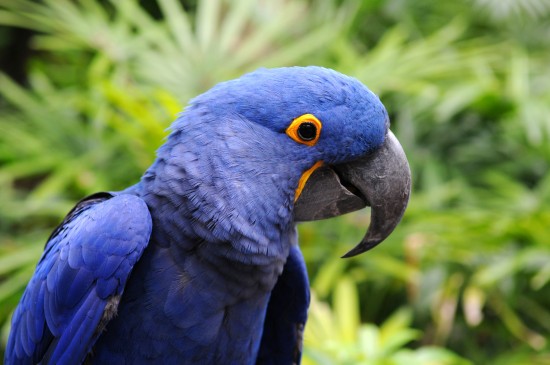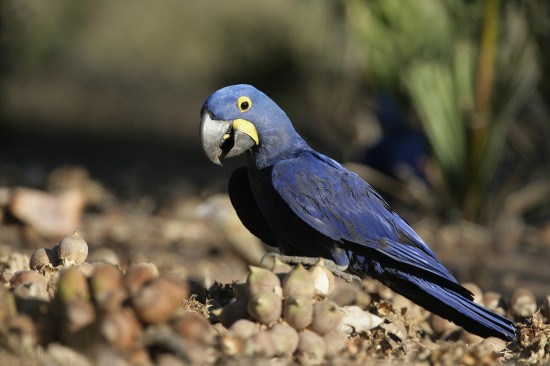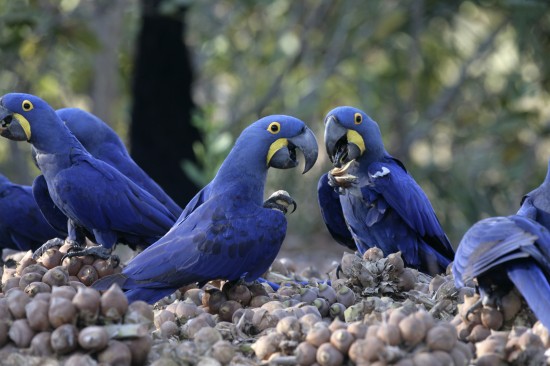



The Hyacinth Macaw (Andorhynchus hyacinthinus) is the largest bird in the macaw family at around 100cm from head to end of the tail and is the largest species of flying parrot. These birds typically weigh around 1.2-1.7kg, and only the Kea from New Zealand is heavier, but this is a ground dwelling bird. The Hyacinth is currently listed as an Endangered Species and comes under Appendix I on the CITES listing.
As its name tells, the Hyacinth has blue feathers with lighter feathers above the wings and the feathers below being darker. It has a typical curved parrot beak which is black with a piece of skin on either side which is called a lappet which is bright yellow. The eye ring is also bright yellow. These big macaws cannot be sexed by visual means but only by tests such as a DNA test. They typically live to the age of 50 years and can breed until they are around 30 years of age.
The Hyacinth is found in three main areas in the wild; the Pantanal region of Brazil, areas nearby in Bolivia and Paraguay; the Cerrado area of Brazil as well as nearby areas with the Tocatins River running through; and the Amazon Basin area. Their preferred habitat is palm swamps and woodland but avoids the mostly densely forested areas, namely due to their size.
The bird is endangered mainly due to habitat loss. Much of the places it lives in have been dramatically altered by cattle ranching, agriculture techniques involving a lot of technology and hydroelectric schemes. Many farmers in these areas also practise annual fire setting to clear land which destroys the Hyacinth’s homes. This has seen the bird being protected by law in Brazil and Bolivia. There is also a scheme underway in the Mato Grosso do Sul state of Brazil, which is ringing the birds and providing artificial nesting sites to help rebuild population numbers.
In the wild, the Hyacinth uses its extremely strong beak to crack all sorts of nuts which cannot be touched by majority of birds. They can crack open coconuts and brazil nuts and enjoy nuts from the palm trees they live amongst. They have a scaly tongue which is also ideal for fruit, nectar, seeds and vegetables. These highly intelligent birds have also been noted to use tools; they will use a small piece of wood to open up nuts which have resisted their beaks.
In captivity, the palm nuts which they get a lot of their calories and natural oils from, are not easily acquired. Raw macadamia nuts with their shells in place make a good substitute, and there are various mixes available specially designed to feed macaws. They will take a variety of fresh fruit and vegetable and need access to fresh drinking water at all times.
Like many parrots, Hyacinths nest in tree cavities or on cliff faces depending on what is available where they live. In the wild, they nest from July to December, and two eggs are laid and are incubated for around 30 days. Usually only one chick survives due to the size differences. As there are a few days between them hatching, the smaller chick is always disadvantaged and often dies.
The chicks fledge from the nest at the age of 110 days but have to depend on their parents for the first six months of their life. They are fully mature and ready to breed in their own right around seven years of age.
To breed in captivity, they require similar conditions to the Scarlet Macaw, despite being larger. The nest box should be around 40inches long and 20 inches square and placed as high as possible. The entrance should face the high traffic areas as the female likes to watch what is going on while sitting on her eggs.
To keep a single or pair of these birds is not something that should be undertaken lightly. Even if the price tag, around £30,000 for a pair, is manageable, these are not the birds to take on if you are not experienced with parrots. For starters, the large beaks on these macaws can be very destructive, so they need the right type of cage to resist them simply breaking out of it. They also need plenty of time outside the cage to exercise those big wings.
When first introducing a hyacinth to the home, it is important to give them time to get acquainted with their surroundings. Most breeders will raise them with a variety of people being introduced to the home, so they take well enough to strangers, but they should be given plenty of time to get used to where they now find themselves.
As mentioned, they are also very intelligent birds which means they need plentiful stimulation or problems can manifest. They like to play with toys inside their cage and outside, but these must be strong enough to withstand their attention. Wooden blocks and branches from trees which are safe for birds are always favourites.
Bathing is another essential element for the happiness of a Hyacinth. On a sunny day, the cage can be moved outside, and the bird sprayed with a fine mist from a hose pipe or a spray bottle. Another option is a proper shower perch for parrots which can be fitted inside the shower cubicle or over the bath and allow the bird to enjoy a real shower!
These big birds have a gentle temperament and take to new people easily. As long as they have the correct entertainment to stave off boredom, much as we humans do, then they are a pleasure to keep. If breeding can be undertaken, they are good, reliable parents who usually rear their own chicks with little drama. Of course, every bird is different, and each has its own personality.
As long as you have the right amount of space and the understanding of the needs of these fantastic parrots, then they will make an excellent addition to any home.
Copyright © 2005-2016 Pet Information All Rights Reserved
Contact us: www162date@outlook.com